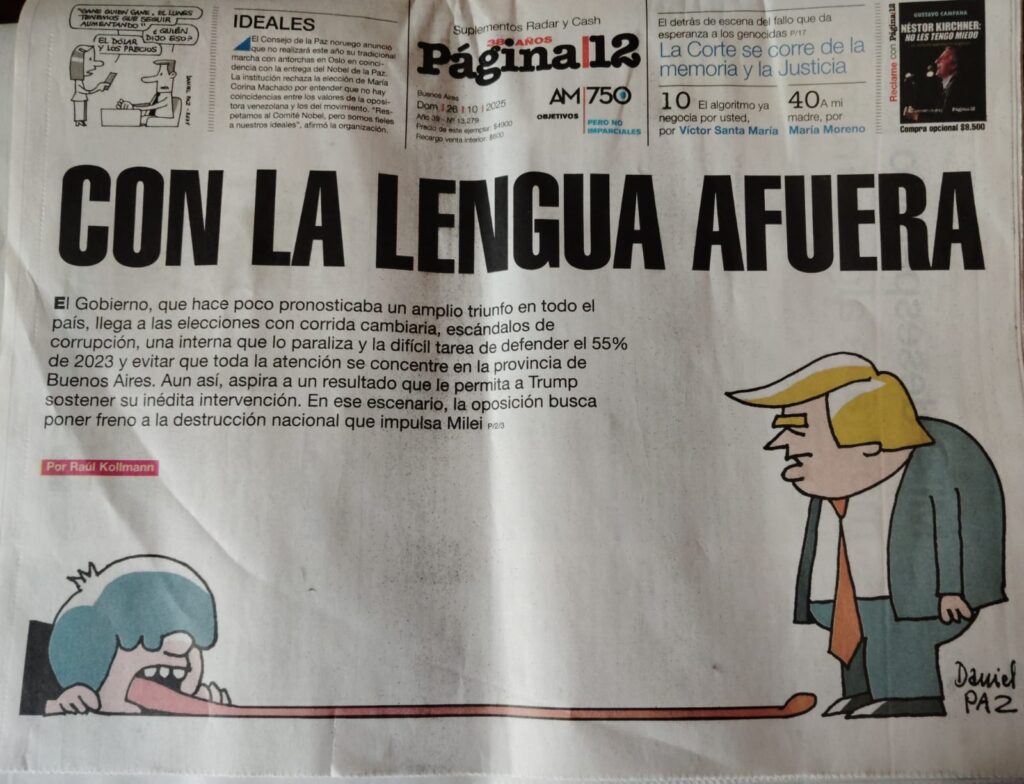
Election Results
Results from the Argentine national mid-term legislative elections came out just before the Day of the Dead, 2025. They demonstrated a continued support for Milei’s LLA Alliance. The Alliance (branded Alianza LLA) is a fusion of Mauricio (el blanco) Macri’s PRO/Republican party and the smaller LLA Libertarian party but its leader is Milei. The alliance received 41% of the vote. Though voting in Argentina is obligatory, only 68% of the electorate actually voted, so the alliance got one vote in three.
That was enough for Trump. He OK’ed Treasury Secretary Bessent’s activation of financial swaps of $20Bn. from the US Treasury with a further twenty more from US private banks, like JP Morgan, to help ‘stabilise‘ Argentina’s purposefully weakened currency. This futile move, always a delay tactic and useful for elections, can also be very profitable for currency speculators and carry-traders.
The nationalist social democrats (in Argentina the Peronists) are supposedly Milei’s opposition. They too play ball with Manhattan banks but they’re just not quite so subservient when it comes to selling off state assets. Peronists suffered a humbling defeat, they are a divided union under a dead Peron and few younger Argentines understand them as much more than a cult. Crucially this result means LLA has enough deputies so block an impeachment for corruption. Milei is now just as impune as Trump. Business —albeit dirty business— can continue. Investors —facilitated by the JP Morgan investment bank that were in town the week of the election— will have a field-day at the cost of Argentine patrimony but that is the debt game if you live in the third world.

Important votes tilted on a knife edge but then dropped on the side of LLA. Buenos Aires province, at 30% of the national population flipped to the LLA. The coalition won by just 1 percentage point but they won; the same pattern occurred in other jurisdictions too. Buenos Aires Province is the most productive part of Argentina’s pampa is about the size of Germany. It encapsulates the national capital city —the Autonomous City of Buenos Aires (or CABA)— which votes as a separate “Autonomous” city state. This richest province it also has some of the country’s poorest people many living in the slums around CABA. In this crucial province Milei’s national vote was up about 14% from the LLA’s disastrous defeat in local elections just two months before. Back then Karina Milei’s Menemite[1] corruption scandal had been broken to the media. This corruption leak was timed for the provincial elections (the scandalous theft had been ongoing for more than a year) but, it seems, it has largely been forgotten.
Milei’s alliance took votes mainly from traditional Peronist and centrist parties, with a notable exception for the left-wing coalition (FIT-U) that did much better in the Capital and it’s suburbs. FIT-U’s leader, Myriam Bregman, took 9.1% of votes in the city of Buenos Aires (CABA) and the party got more than 5% of the vote in Buenos Aires province. Mirroring Europe shortly after the Euro crisis Argentina demonstrated votes moving to extremes. In Argentina’s case to the populist hard right of Milei’s LLA alliance and toward FIT-U socialism. Centrist coalitions, like Peronist factions and the almost defunct UCR, lost votes to both extremes. Various new Federalist alliances by groups of provincial governors also failed to attract voters.
Milei’s Social Voter Base
Similar to when Milei was elected president, almost two years before, his support comes from a two key voting segments, the disaffected youth (both rich and poor, but mainly male) and traditional older conservatives in the upper middle classes (both men and women). Curiously with Milei’s policies that exclusively favour the rich, the younger Milei fans are mostly working class. They voted against an economic slump and corruption; they vote against hopelessness. Theirs is a life of low wages and high inflation. Many voted for Milei again even after their lives had become harsher as the economy shrank under his government, even as prices tripled even in US Dollar terms (5-7x in pesos in just two years). Milei’s support has waned from his presidential election days but he held a right wing coalition that defeated the broken opposition who will need to reflect on this collapse. Some voters with a conscience continue to critique Milei’s destruction of the health service — notably the Garrahan Central children’s hospital and Milei’s abismal treatment of poor pensioners. Possibly as a small gesture to them Milei gave these pensioners an extra $10 bucks a week after his election win. His other key backers are the upper middle class: centre-right urban sectors, large land-owners and elites. They tend to be less phased by corruption but vote against taxation and to punish Peronism which frightened them in middle of the last century when it experimented with a failed land-reform (Peron was dragged back from exile and destroyed the initiative resulting in a low-level civil war and various coup d’états and bouts of state terror. Many of this latter category haven’t benefited from Milei’s economic policies —only the very rich are doing better, the middle classes are often highly indebted and much poorer— still align themselves with the interest of the very rich similar to the US MAGA voters a social phenomenon of mass manipulation is often aided by social media manipulation and AI-assisted targeting.
Trump Threat
In geostrategic terms Trump is focused more on the Americas than Biden, the latter was more focused on US proxy wars in the Middle East (via Israel) and in Russia (via Ukraine) as well as threatening China (which has not gone too well for either). Unfortunately for Latin America this also means that US-Southcom is also more militarily focused on South America, as evidenced by murderous attacks on boats off the Venezuelan coast.
Trump & Milei also cohabit an extreme conservative political space called the American Conservative Union ( CPAC.ORG ) which is aligned with ultra-conservative think tanks like the Atlas Network. Personally —and everything is personal with Trump— the US president seems to like Javier Milei in a teddybear-cum-court-jester kind of way. Trump indulges Milei when he comes to his expensive parties at Mar-a-Lago by playing YMCA and sending family to make him feel loved.
More seriously, Trump’s advisors consider that Argentina’s break with BRICS+ —as well as Milei’s fanatical support for Netanyahu— are also of strategic importance to the US which is worried about Brazil and Colombia increasing independence as well as the global importance of BRICS. Trump decided to exert financial pressure, taking advantage of Milei’s disastrous libertarian economic policies, by leveraging “a dollar shortage”.
Dollar “Shortages”
The shortage of dollars are a constant myth in Argentina. In reality dollars leave Argentina as an indirect result of their bi-monetary economy (pesos and dollars playing different roles) not because of too many imports or too few exports.
As a commodity exporting nation —exports in commodities are done in US dollars for now—Argentina should be swimming in dollars. Indeed it is! However the government can only tax in pesos. Savings are done in dollars and often offshored and hidden abroad in Europe, Miami and Uruguay by wealth elites including some politicians. Any dollar “shortfall” is only felt by the government sector (and the poor) and are likely to become more of a problem because of the debt which is rising under Milei.
Two months before the election Trump pushed the IMF to give another illegal loan to Argentina to stave off debt payment default, though doing so broke IMF rules. The World Bank also chucked in a few billion. This wasn’t enough for Milei’s shrunken economy and dollar-hungry elites. Lower taxation and ludicrously high internal prices kept the brakes slammed on the local economy and the central bank is bleeding dollars to local savers who don’t save in pesos because of historical (as well as recent) devaluations.
Locals in Argentina don’t trust the peso and they have good reason. Only the rich can save and they know how the local elite force devaluations regularly. The first thing Milei did when he took power was to devalue the peso by more than 100%. The month before he came to power (November 2023) the peso-to-dollar official rate was 310 pesos-to-the-dollar. In December 2023 that devalued 124% to 810 pesos to the dollar and by the end of his first year in office it had reached 1000 Pesos to the dollar. By the elections that had reached 1500 Pesos-to-one dollar. Milei reacted as did previous governments by bleeding pesos in 70%+ interest rates to try and keep savers in pesos (a futile attempt that instead brought in the carry traders who sucked money out of the country changing it back into US dollars on the way out).

So just two weeks before the election Trump announced the same amount of money again to help his little buddy, this time as a swap and not an IMF loan. Again this was to stave off currency instability and another possible financial collapse. Now the manacles are firmly placed on Milei’s government and they have to comply with anti-China measures or whatever JP Morgan tells them to do. Total subservience to the US financial sector will follow. Mining of uranium was explicitly mentioned too. Milei is, of course, fine with this. On election day the Página/12 national newspaper printed a front page caricature Milei on his knees with his tongue on the floor at Trump’s feet.
The extraordinary presence of a former UK prime minister, sheiks from the UAE and most of the cupola of JP Morgan bank the week of the elections announced the new rules for those who want to see. Trump said all of this was contingent on a positive election result for Milei’s LLA coalition. Milei, a libertarian anti-nationalist, encourages such privatisation of the state even though he is the state’s highest representative. His favourite somewhat psychotically: “I am the mole who will destroy the state from within.” Few of his fans seen to question whether this is really a president’s job.
Milei must now try out an experimental hybrid of banking and pseudo-democratic control. Such a system is totally incompatible with any constitution but the constitution is not Milei’s strong-point, that is right wing populist theatrics. An economic analyst, consulted by the author, noted explicitly that “Argentina will test a new hybrid model of private governance”. The first clear step in this direction was removing the new Minister for International Relations and replacing him with a former JP Morgan-Chase executive Pablo Quirno. The government is intervened by JP Morgan, a US-based investment bank.
JP Morgan is an Investment bank. It provides two main services: Investment advice on merger and acquisition contracts and private banking (sophisticated dollar extraction streams) for the extremely rich who prefer their profits abroad. This should suit Milei’s bosses —la “gente de bien” he calls them— just fine. It augurs a fire-sale of Argentina public assets to pay debt, as happened first with Menm and then (to a lesser extent) with Macri. This same debt that Milei increased to try to ‘rescue’ the peso. If JP Morgan play their cards right maybe they can now be on both sides of such trades possibly even getting involved in price setting for state assets.
How’s that for sovereignty?
Historical Lessons
While Milei’s version of extreme neoliberalism may have a light Libertarian rebranding, it has been tried and executed before. Two of Milei’s heroes have done something very similar and largely with the same Menemist team (including members of the Menem family like the speaker of the house, Martín Menem and his lovely cousin Lule Menem who moves the stolen cash). Previous presidents also hired Morgan-Chase executives. Toto Caputo had the same role in Macri’s government and many of Milei’s older ministers were active with Carlos Menem and are still active now. So much so that one might call these last four decades the 3-M’s: Menem, Macri then Milei. The stage play goes something like this:
- Take on more dollar-denominated debt, reducing taxation on the rich, and giving free access to dollars to the very rich in Argentina so that they sell their pesos and export the dollars. This devalues the peso currency and creates the “shortage” of local dollars. Argentina call this an expensive dollar but it really is a cheaper unwanted peso (which is inconvertible abroad).
- Bump up bond interest rates and encourage unproductive payments to investors in pesos. The carry trade phase which expands private and public debt creating a casino economy in the local banking sector till that crashes.
- When foreign debt payments (plus the payments of generous interest in pesos) overcome taxation then privatise government assets (the excuse being to stave off inevitable financial collapse) then try to win another election. Menem won another election and the collapse was worse in 2001-2002, Macri did not.
The results depend on whether the government manages to make two terms. If they do then the collapse is catastrophic, if not then the next government is faced with massive debt problems and restructuring. Either way it takes years, if not decades, to partially recover from the collateral damage to society. Huge profits are made by rich locals and the global financial vulture capital sector. This comes at the cost of local jobs, human rights and increased poverty. This disastrous financial strategy is not new but it is quite possible that Milei’s accelerated recipe shows the most severe disdain for societal costs. Extreme libertarian doctrine does not just allow all this kind of destruction of the state, it encourages it in an extreme Darwinian live and let die way. A rising tide floats the largest boats (like Paul Singer’s private yachts) with the largest fortunes and drowns the rest.
The financial playbook is simple. Burn through dollars held by the Argentine Central Bank (BCRA) — accumulated through exports— with a compliant State Treasury trying to fight an innate pressure on peso devaluation (one that intentionally ignores the bi-monetary economy). Keep the economy oriented toward a commodity export-focus with low wages in pesos paid by an oligarchic sector who benefit from these exports paying wages and taxes in constantly devaluing pesos. Meanwhile keep real-estate and most savings completely dollarised (offshore of course).
This constantly bleeds dollars out of the economy and pushes up the costs of imports in pesos which are then matched by internal pricing, creating vast fortunes made by local manufacturers, a local sector with little or no incentive to compete within a closed market. The result is low wages, high prices and collapsing internal demand wiping out jobs then an inevitable financial collapse triggered by an external debt default. It has already made Argentina much more expensive than its neighbours. In Argentina, the land of beef, an Argentine hamburger with a US brand costs more than the same hamburger in New York even in dollar terms at 1500-to-$1.
The stability swap offered to Milei by Trump will be useful for now by pushing out financial collapse but doesn’t permanently alleviate the requirement for a growing influx of dollars and a smaller outflow of dollars. The BCRA can accumulate reserves and make debt payments but it won’t it will pay them out to carry traders. Unpayable financial debt at high interest rates have already been converted to IMF debt, this will just require the export of tens of billions from the nation’s negative dollar reserves. These measures will soon time out. ‘Rescuing’ Argentina is very unpopular in the US already. If things keep going as they are, and there is no indication of a major improvement yet, then another debt crisis will be inevitable. This is not all Milei’s fault but he certainly made the situation much worse. Maybe Argentina should have joined BRICS+ after all.
It’s dollar addicted ruling classes would never let it do so.
[1] The family of the famously corrupt president of Argentina Carlos Menem which have spawned almost all presidents since then including Milei.

Leave a Reply